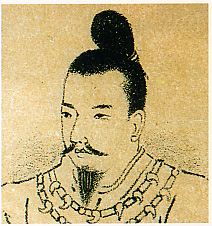Kōan (Tennō)
Kōan ( Japanese 孝 安天皇 , Kōan-tennō ; according to tradition * 427 BC ; † 291 BC ) was according to the old imperial chronicles Kojiki and Nihonshoki the 6th Tenno of Japan (392 BC – 291 BC). Chr.). Its historical existence is doubtful. He is one of the "eight undocumented emperors" ( 欠 史 八 代 kesshi hachidai ), of which only a sketchy representation is known.
His proper name was after the Nihonshoki (N) Yamato-tarashi-hiko-kuni-oshi-hito no mikoto ( 日本 足 彦 国 押 人 尊 ) and his mother Yoso-tarashi-hime ( 世襲 足 媛 ), after the Kojiki (K ) his name was Ō-yamato-tarashi-hiko-kuni-oshi-hito no mikoto ( 大 倭 帯 日子 国 押 人命 ) and his mother Yoso-taho-hime no mikoto ( 余 曽 多 本 毘 売 命 ). On the 14th day of the first lunar month in the 68th year of reign (408 v. Chr.) His father Kosho he was appointed at the age of 20 years for the crown prince and took over after his death on the 27th day of the 1st lunar month of the following year (392 v . Chr.) The throne.
Kōan ruled in the Akizushima Palace (N: 室 秋 津 島 宮 , K: 葛 城 室 之秋 津 島 宮 , (Kazuragi) Muro no Akizushima no miya ) in Muro (now part of Gose ) in the Kazuragi district. He took his niece as his wife, who according to the Nihonshoki Oshi-hime ( 押 媛 ) or according to the Kojiki Oshika-hime no mikoto ( 忍 鹿 比 売 命 ) was. This gave him Ō-yamato-neko-hiko-futo-ni no mikoto (N: 大 日本 根子 彦 太 瓊 尊 , K: 大 倭 根子 日子 賦 斗 邇 命 ). The Kojiki also mentions an older son named Ō-kibi-no-moro-susumi no mikoto ( 大吉 備 諸 進 命 ).
He died after the Nihonshoki at the age of 102 on the 9th day of the 1st lunar month in his 102nd year of reign (291 BC), after the Kojiki at the age of 123. His mausoleum ( misasagi ) is the tumulus Tamate-no-oka-no-e-no-misasagi ( 玉手 丘 上 陵 , 'Imperial tomb on the hill of Tamate'; 34 ° 27 ′ 18 ″ N , 135 ° 44 ′ 56 ″ O ) in the Tamade district of Gose. His successor was Ō-yamato-neko-hiko-futo-ni.
The name Kōan, whose characters mean " filial piety " and "peace", he received later when the Japanese emperors began to give themselves Chinese or Sino-Japanese, often Buddhist-inspired names.
Individual evidence
- ^ A b c d e William George Aston: Nihongi: Chronicles of Japan from the Earliest Times to AD 697 . Trench, Trübner & Co., London 1896, p. 145–146 ( Text Archive - Internet Archive ). Copy of Nihonshoki (Japanese)
- ↑ a b c d e Basil Hall Chamberlain: The Kojiki . 1919, Section LIX - Emperor Koan ( sacred-texts.com ).
- ↑ 天 皇陵 - 孝 安天皇 玉手 丘 上 陵 . Kunai-chō , accessed October 6, 2017 (Japanese).
| predecessor | Office | successor |
|---|---|---|
| Kosho |
Tennō 392-291 BC Chr. |
Kōrei |
| personal data | |
|---|---|
| SURNAME | Koan |
| ALTERNATIVE NAMES | 孝 安天皇 (Japanese) |
| BRIEF DESCRIPTION | 6. Tennō of Japan (392 BC – 291 BC) |
| DATE OF BIRTH | 427 BC Chr. |
| DATE OF DEATH | 291 BC Chr. |

